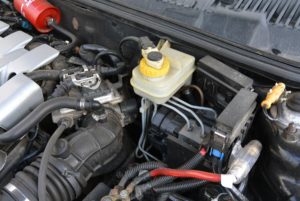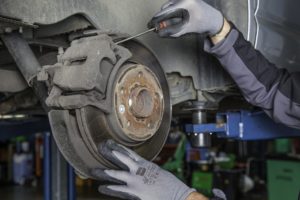Auto brake repair is a commonly misunderstood part of routine service. You may have experienced bit of confusion regarding brake repair cost and what is actually necessary when it comes to preventative maintenance on this all-important safety system. The following is a simple explanation of the parts that should normally be checked as part of a brake service.
Understanding Your Brake System… what you need to know!
Clean fluid is crucial to the proper operation of any brake system. You want to have your fluid flushed every two years, regardless of miles driven. This is because brake fluid absorbs moisture and contamination, which has a notable impact on its performance.
When the old brake fluid is removed, it takes contamination with it. This helps to preserve the life of system components such as hydraulic parts, lines, anti-lock brake modules.
You are probably more familiar with the “normal” service involving putting on a set of replacement brake pads and/or rotors.
Many modern cars use brake discs on both the front and rear wheels, but some still use older style brake drums on the rear. The wear components to consider in a disc/drum setup are still the typical pads and rotors at the front along with brake drums and shoes at the rear. The function of the two systems is different, but both apply the needed vehicle stopping power.
I get a lot of questions about “trimming” (machining/cutting) brake drums and rotors. Let me see if I can clear this up for you.
The machining process consists of putting the brake part on a lathe and smoothing any surface imperfections. With labor rates being what they are, there may not be any benefit to machining old rotors. Since production costs have decreased in recent years, prices for brake discs have dropped.
This means the rates a shop may charge to machine old parts may make putting on new rotors or drums a wise move for the vehicle owner. Additionally, new parts will last longer and be more resistant to warping. Simply put, many times it’s just not worth it to “trim” your rotors.
Along with wear items, parts such as slide pins, dust boots and you will want your brake lines to be given a careful inspection.
Any fluid leaks or torn rubber should be addressed before they become safety issues or lead to a more expensive problem down the road.
As long as it is maintained, your brake system will tend to be rather trouble-free. When problems do arise they are often a result of neglect or a history of skipped services.
By keeping up with scheduled service intervals, any modern brake system should provide reliable stopping with minimal cost.
Brake repair costs will vary depending on what needs to be done to get you back on the road and driving safely.
Many service stations such as Midas will perform a basic brake check to determine the extent of any problems. If you hear any brake noise such as screeching, squeaking or grinding, you should immediately have your brakes checked.
Common Brake Repairs
There are several things that can go wrong with brakes. Worn out brake pads, calipers and drums might be the issue, but it could also be a problem with your master cylinder, individual wheel cylinders or simply a lack of fluid. The cost of repairing brake problems fluctuates depending on what is wrong.
Common Brake Repair: Low Fluid
 The easiest of brake problems simply involves a low amount of brake fluid in the master cylinder. Removing the cap and topping off the fluid is the way to fix it, but keep in mind, if the master cylinder is empty, pouring more fluid in will push air into the system. To fix this you will have to bleed the brakes. If you can’t do this yourself, it will cost some labor hours with a mechanic.
The easiest of brake problems simply involves a low amount of brake fluid in the master cylinder. Removing the cap and topping off the fluid is the way to fix it, but keep in mind, if the master cylinder is empty, pouring more fluid in will push air into the system. To fix this you will have to bleed the brakes. If you can’t do this yourself, it will cost some labor hours with a mechanic.
Common Brake Repair: Worn Pads or Drums
Worn pads and drums are a standard brake repair. Because brakes use friction to stop the car, as time wears on, so do the brake pads. It’s just a simple fact of physics. Friction causes wear. After a while, brake pads must be replaced.
You will detect a need to replace pads by hearing gradually increasing squeaking whenever you hit the brakes.
If it goes on too long without being replaced, eventually you may have to replace the drums and/or rotors as well. At this point, what could have been a relatively inexpensive fix is now more expensive. A standard replacement of pads may cost $75 to $100. A drum, rotor, and/or caliper replacement can get up into the several hundreds depending on the extent of the problem.
Common Brake Repair: Master Cylinder and Wheel Cylinders
 The master cylinder is where the brake fluid is stored and is sent to each wheel cylinder through pressure. This fluid is what applies force to the pads and drums when you press down on the brake pedal.
The master cylinder is where the brake fluid is stored and is sent to each wheel cylinder through pressure. This fluid is what applies force to the pads and drums when you press down on the brake pedal.
If the master cylinder goes bad, when you press down on the brake pedal, it might go to the floor and take longer to stop the car. At best, your braking power is greatly reduced; at worst, it could endanger your life by not stopping the car.
The average cost of master cylinder repair is usually between $200 and $300, but it can be more, depending on the scope of the fix. The cost of brake repair will go up if individual wheel cylinders need to be replaced.
The repair price for an entire brake job—rotors, calipers, drums, pads, cylinders—can run you $750 or more. Therefore, it’s best to stay on top of brake repair and replace brake pads when you hear squeaking.
Components like master cylinders wear down after time, so eventually, they will have to be replaced. As long as you keep brake fluid in it and keep an eye on it, though, you’ll be safe to drive and can take the steps to have it fixed when it comes time.
